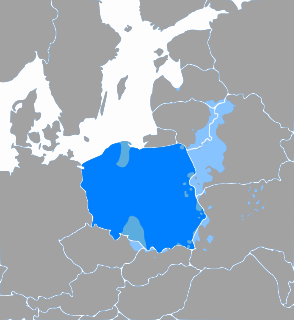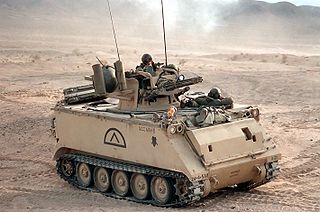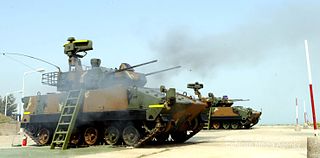The ZSU-23-4MP "Biała" (pl. White , also the name of more than one small Polish river) is a Polish modification of the ZSU-23-4 "Shilka" self-propelled anti-aircraft gun. The ZSU-23-4MP "Biała" includes a new digital optical targeting system and 4 Grom surface-to-air missile launcher. The AZP-23 autocannons are equipped with modern ammunition and have an increased effective anti-aircraft range to about 3.5 km, 0.5–1 km more than the original ZSU-23-4. The Grom missiles' maximum range is about 5.5 km.

Polish is a West Slavic language of the Lechitic group. It is spoken primarily in Poland and serves as the native language of the Poles. In addition to being an official language of Poland, it is also used by Polish minorities in other countries. There are over 50 million Polish language speakers around the world and it is one of the official languages of the European Union.

White is the lightest color and is achromatic. It is the color of fresh snow, chalk, and milk, and is the opposite of black. White objects fully reflect and scatter all the visible wavelengths of light. White on television and computer screens is created by a mixture of red, blue and green light.
Around 70 ZSU-23-4MP "Biała" self-propelled anti-aircraft guns are to be produced for the Polish army, as a cheaper alternative to the modern Polish 35 mm PZA Loara self-propelled anti-aircraft gun.

The PZA Loara is a Polish armored radar-directed self-propelled anti-aircraft gun system. The original PZA Loara prototype was based on the chassis of the T-72M tank. The production version known as PZA Loara-A is based on the chassis of the PT-91 MBT.
This page is based on this
Wikipedia article Text is available under the
CC BY-SA 4.0 license; additional terms may apply.
Images, videos and audio are available under their respective licenses.

An anti-aircraft vehicle, also known as a self-propelled anti-aircraft gun (SPAAG) or self-propelled air defense system (SPAD), is a mobile vehicle with a dedicated anti-aircraft capability. The Russian equivalent of SPAAG is ZSU, for zenitnaya samokhodnaya ustanovka,.

The Flugabwehrkanonenpanzer Gepard is an all-weather-capable German self-propelled anti-aircraft gun (SPAAG). It was developed in the 1960s and fielded in the 1970s, and has been upgraded several times with the latest electronics. It constituted a cornerstone of the air defence of the German Army (Bundeswehr) and a number of other NATO countries. In Germany, the Gepard was phased out in late 2010 to be replaced by "Leichtes Flugabwehrsystem (LeFlaSys)", a mobile and stationary air defence system using the LFK NG missile and the new MANTIS gun system. The mobile platform of SysFla will likely be based on the GTK Boxer.

The M163 Vulcan Air Defense System (VADS) is a self-propelled anti-aircraft gun (SPAAG) that was used by the United States Army. The M168 gun is a variant of the General Dynamics 20 mm M61 Vulcan rotary cannon, the standard cannon in most U.S. combat aircraft since the 1960s, mounted on either an armored vehicle or a trailer.
The Polish military continues to use some Soviet-era equipment; however, since joining NATO in 1999, Poland has been upgrading and modernizing its hardware to NATO standards. The General Staff has been reorganized into a NATO-compatible J/G-1 through J/G-6 structure. Recent modernization projects include the acquisition of (48) F-16 fighter jets from the United States, (256) Leopard 2 MBTs from Germany, ATGM technology from Israel, and (957) Patria AMV AFVs from Finland.

The ZSU-57-2 Ob'yekt 500 is a Soviet self-propelled anti-aircraft gun (SPAAG), armed with two 57 mm autocannons. 'ZSU' stands for Zenitnaya Samokhodnaya Ustanovka, meaning "anti-aircraft self-propelled mount", '57' stands for the bore of the armament in millimetres and '2' stands for the number of gun barrels. It was the first Soviet mass-produced tracked SPAAG. In the USSR it had the unofficial nickname "Sparka", meaning "twin mount", referring to the twin autocannon with which the vehicle is armed.

The Grom is a man-portable air-defense system produced in Poland and based on the Russian man-portable infrared homing surface-to-air missile (SAM) 9K38 Igla. It consists of a 72 mm anti-aircraft missile set with a flight speed of 650 m/s, as well as a single-use launcher, re-usable gripstock and thermal battery coolant assembly electric unit. The full name of the system is PZR Grom, PZR standing for Przeciwlotniczy Zestaw Rakietowy.

The 2K22 Tunguska is a Russian tracked self-propelled anti-aircraft weapon armed with a surface-to-air gun and missile system. It is designed to provide day and night protection for infantry and tank regiments against low-flying aircraft, helicopters, and cruise missiles in all weather conditions. Its NATO reporting name is SA-19 "Grison".

The South Korean K30 Biho twin 30 mm self-propelled anti-aircraft weapon was developed to meet the operational requirements of the Republic of Korea Armed Forces for a highly mobile short range air defense system suited to the operational and terrain conditions of the Korean peninsula. It combines an electro-optically guided 30 mm gun system with a surveillance radar system on a K200 chassis. It supplements the K263A1 Chungung, a self-propelled 20 mm Vulcan system. The K30 is primarily built by Hanwha Defense Systems.

The Islamic Republic of Iran Khatam al-Anbia Air Defense Base is a branch split from IRIAF and part of Islamic Republic of Iran Army that controls Iran's military land-based air defense established in 2008.

Marksman is a British short range air defense system developed by Marconi, consisting of a turret, a Marconi Series 400 radar and two Swiss Oerlikon 35 mm anti-aircraft autocannons. It is similar to the German Gepard system in terms of engine performance, ammunition carried and effective range of the ammunition.

ZSU-37 was a Soviet-made, light, self-propelled anti-aircraft gun (SPAAG), developed by the end of 1943 and produced at Works No. 40 in Mytishchi. It was the first Soviet series-produced tracked SPAAG. ZSU stands for Zenitnaya Samokhodnaya Ustanovka, meaning "anti-aircraft self-propelled mount".

The ZSU-23-4 "Shilka" is a lightly armored Soviet self-propelled, radar guided anti-aircraft weapon system (SPAAG).
The full structure of the Polish Land Forces is:

The Hibneryt is a Polish armored radar-directed self-propelled anti-aircraft gun system. A ZU-23-2 or ZUR-23-2S short-range air defense towed twin 23 mm autocannon fitted onto the Star 266's truck bed which has been modified and elevated to allow the AA gun to fire more freely. The wheels haven't been removed which allows the crew to remove the autocannon if need be which can be used as it originally was. The vehicle carries the ammo and equipment for the AA gun.
The KORKUT is a Turkish all-weather-capable 35 mm self-propelled anti-aircraft gun (SPAAG) developed by ASELSAN.















